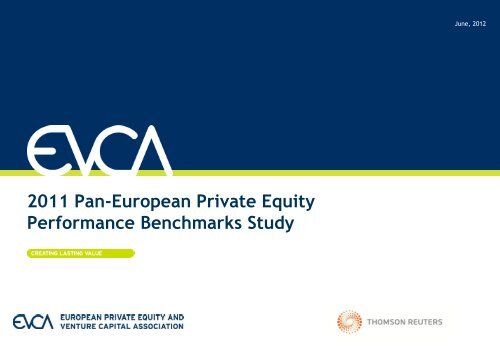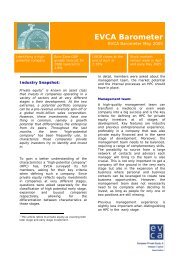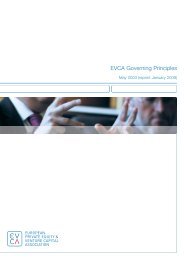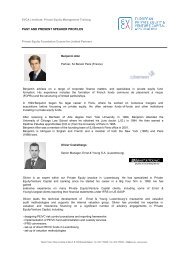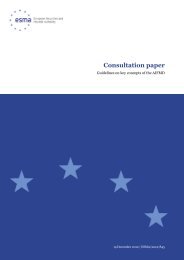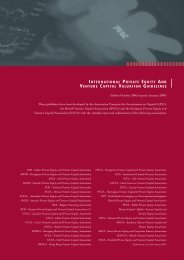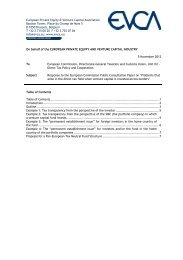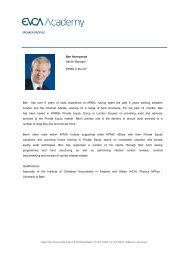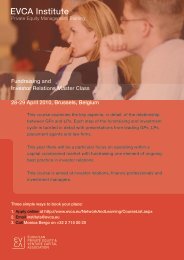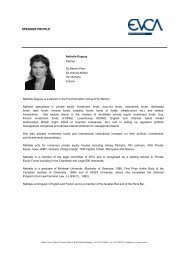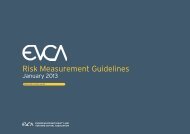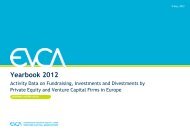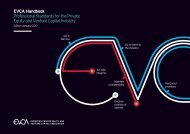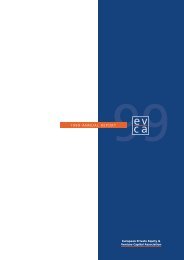2011 Pan-European Private Equity Performance ... - EVCA
2011 Pan-European Private Equity Performance ... - EVCA
2011 Pan-European Private Equity Performance ... - EVCA
- No tags were found...
You also want an ePaper? Increase the reach of your titles
YUMPU automatically turns print PDFs into web optimized ePapers that Google loves.
Top Quarter: Annualised net pooled since inception and horizon IRRTable 3: Top-quarter funds formed 1980–<strong>2011</strong>Horizon IRRFund stage No. of Funds Pooled IRR 1-year IRR 3-year IRR 5-year IRR 10-year IRRSeed/Early-stage 115 12.52 17.20 9.97 6.05 6.72Later-stage 30 17.49 20.36 10.28 6.53 6.12Balanced 48 15.98 2.01 15.55 4.40 5.62All venture 193 13.20 5.01 13.83 4.97 6.00Buyout 117 30.09 15.31 14.88 11.28 19.73Generalist 36 11.52 -14.61 6.63 -5.13 3.41All private equity <strong>2011</strong> 358 22.54 10.49 13.44 6.86 12.96All private equity 2010 355 22.81 26.36 2.02 14.40 10.81Source: Thomson Reuters| Creating lasting value | 9
Top Half: Annualised net pooled since inception and horizon IRRTable 4: Top-half funds formed 1980–<strong>2011</strong>Horizon IRRFund stage No. of Funds Pooled IRR 1-year IRR 3-year IRR 5-year IRR 10-year IRRSeed/Early-stage 230 7.02 11.07 5.59 2.60 2.52Later-stage 60 12.65 19.70 6.04 2.98 1.50Balanced 96 7.80 0.67 11.74 4.21 4.27All venture 385 8.04 4.15 9.19 3.55 3.26Buyout 233 19.23 6.43 11.57 8.13 15.05Generalist 72 11.17 -8.42 5.89 -3.61 4.01All private equity <strong>2011</strong> 716 13.95 5.89 10.64 5.80 11.02All private equity 2010 710 14.33 22.18 2.47 13.40 10.33Source: Thomson Reuters| Creating lasting value | 10
<strong>Performance</strong> per quarter and Top-half performance - explainedThomson Reuters offers two methods of quartile analysis:Method 1: Quartile position is based on primary market, fund stage and fund year (historical method)• Here, it is possible to have a fund with a negative return in the top quartile based on its peer group, but have anotherfund in the 2nd, 3rd or 4th quartile with a positive return because of its peer group.Method 2: Quartile position based on selected search criteria and report end date (newly introduced, allows user to create acustom peer group)• Here, the user selects their sample criteria to create a custom peer group. The funds are then assigned to quartilegroups based on their cumulative IRR as of the report end date selected by the user. The second method was used toproduce the top-quarter and top-half returns in this report (<strong>Performance</strong> ranking). As this method of quartileassignment is not currently available for pooled horizon or rolling horizon report types, IRR range was used as asearch criteria to produce the pooled horizon returns in this section, with the range defined at the lower end by thequartiles (upper and median) obtained from the standard cumulative returns report.| Creating lasting value | 11
<strong>Performance</strong> by fund sizeTable 5: Buyout funds performance by fund size to 31.12.<strong>2011</strong>Fund Size* No. of Funds Pooled IRR 1-year IRR 3-year IRR 5-year IRR 10-year IRREUR 0-250m 288 10.39 10.02 5.54 3.97 5.81EUR 250m-500m 72 20.00 10.29 6.81 2.85 8.67EUR 500m-1bn 50 13.47 7.26 6.88 7.30 7.09EUR 1bn+ 56 9.32 4.64 9.11 1.53 9.13All buyout <strong>2011</strong> 466 11.42 5.50 8.34 2.41 8.33All buyout 2010 462 12.09 19.82 -2.51 7.01 8.69Source: Thomson Reuters*The fund size intervals should be read [x,y), so open interval to the right.| Creating lasting value | 12
<strong>Performance</strong> by fund sizeTable 6: Venture funds performance by fund size to 31.12.<strong>2011</strong>Fund Size* No. of Funds Pooled IRR 1-year IRR 3-year IRR 5-year IRR 10-year IRREUR 0-50m 525 3.30 0.14 0.78 -1.94 -1.60EUR 50m-100m 115 0.77 -2.00 1.36 -1.93 -2.71EUR 100m-250m 96 0.77 6.78 1.36 -1.92 -3.24EUR 250m+ 34 1.03 2.74 8.73 1.83 1.39All venture <strong>2011</strong> 770 1.51 2.68 4.88 -0.14 -0.94All venture 2010 765 1.35 17.53 -1.38 0.05 -2.27Source: Thomson Reuters*The fund size intervals should be read [x,y), so open interval to the right.| Creating lasting value | 13
Net IRR (%)<strong>Performance</strong> by vintage yearTable 7: Annualised net pooled IRR by vintage years from inception to 31.12.<strong>2011</strong>1980-1984 1985-1989 1990-1994 1995-1999 2000-2004 2005-2009 2010-<strong>2011</strong>IRR DPI IRR DPI IRR DPI IRR DPI IRR DPI IRR DPI IRR DPIVenture 6.27 1.66 6.84 1.5 13.11 1.68 1.05 0.65 -3.44 0.31 3.28 0.14 -6.27 0.00Buyout 8.33 1.91 13.32 1.64 16.92 1.98 11.63 1.42 18.28 1.37 1.34 0.24 12.22 0.00All private equity 6.76 1.72 8.63 1.21 15.6 1.89 9.92 1.29 12.58 1.18 1.91 0.23 -4.76 0.01Source: Thomson ReutersFigure 2: <strong>Performance</strong> by vintage year for all private equity50%40%3.53.0TVPIMultiple30%20%10%0%1989 1990 1991 1992 1993 1994 1995 1996 1997 1998 1999 2000 2001 2002 2003 2004 2005 2006 2007 2008 2009 2010 <strong>2011</strong>2.52.01.51.00.5-10%Net IRRTVPISource: Thomson Reuters0.0| Creating lasting value | 14
Short-, medium- and long-term returns reflected by net horizon IRRsTable 8: Horizon IRRs to 31.12.<strong>2011</strong> (Funds formed 1980-<strong>2011</strong>)Fund stage 1-year IRR 3-year IRR 5-year IRR 10-year IRR 20-year IRRSeed/Early-stage 5.05 -0.13 -2.86 -3.15 -1.06Later-stage 10.98 2.99 -0.32 -1.54 2.93Balanced 0.53 9.95 2.57 1.88 4.09All venture 2.68 4.88 -0.14 -0.94 1.46Buyout 5.50 8.34 2.41 8.33 11.26Mezzanine 16.32 9.58 5.69 7.30 8.88Generalist -11.47 4.00 -3.78 3.23 11.48All private equity <strong>2011</strong> 4.75 7.50 1.55 5.62 9.23All private equity 2010 18.44 -2.20 5.45 5.09 9.48Source: Thomson Reuters| Creating lasting value | 15
Short-, medium- and long-term returns reflected by net horizon IRRsFigure 3: Five-year rolling IRRs (Funds formed 1980-<strong>2011</strong>)35%30%25%20%Net IRR (%)15%10%5%0%-5%1991 1992 1993 1994 1995 1996 1997 1998 1999 2000 2001 2002 2003 2004 2005 2006 2007 2008 2009 2010 <strong>2011</strong>-10%Venture Buyout GeneralistSource: Thomson Reuters| Creating lasting value | 16
A geographic perspective to fund performanceFigure 4: Five-year rolling IRRs for Europe and the US70%Net IRR (%)70%Net IRR (%)60%60%50%50%40%40%30%30%20%20%10%10%0%0%-10%-10%-20%<strong>European</strong> Venture<strong>European</strong> Buyout-20%US Venture US Buyout Source: Thomson Reuters| Creating lasting value | 17
A geographic perspective to fund performanceFigure 5: Five-year rolling IRRs global benchmark for all private equityNet IRR (%)40%35%30%25%20%15%10%5%0%-5%1991 1992 1993 1994 1995 1996 1997 1998 1999 2000 2001 2002 2003 2004 2005 2006 2007 2008 2009 2010 <strong>2011</strong>-10%US Global EuropeSource: Thomson Reuters| Creating lasting value| 18
A geographic perspective to fund performanceTable 9: Horizon IRRs to 31.12.<strong>2011</strong> for Europe and the USFund stage Region 1-year IRR 3-year IRR 5-year IRR 10-year IRRVenture Europe 2.68 4.88 -0.14 -0.94US 11.59 7.87 3.54 -1.01Buyout Europe 5.50 8.34 2.41 8.33US 13.91 13.29 5.50 4.61All private equity Europe 4.75 7.50 1.55 5.62US 12.80 12.50 5.64 3.54Source: Thomson Reuters| Creating lasting value | 19
Public market comparators*Table 11: Horizon IRRs to 31.12. <strong>2011</strong>1-year IRR 3-year IRR 5-year IRR 10-year IRRSeed/early-stage<strong>Private</strong> <strong>Equity</strong> 5.05 -0.13 -2.86 -3.15JP Morgan Euro Bonds (EMBI+) 13.71 17.36 9.67 8.29HSBC Small Company <strong>Equity</strong> -20.57 14.30 -6.96 2.51Morgan Stanley Euro (MSCI) -16.61 -0.09 -10.10 -4.08Later-stage<strong>Private</strong> <strong>Equity</strong> 10.98 2.99 -0.32 -1.54JP Morgan Euro Bonds (EMBI+) 13.30 17.36 9.34 8.04HSBC Small Company <strong>Equity</strong> -20.97 14.58 -7.04 3.08Morgan Stanley Euro (MSCI) -17.27 -0.02 -10.06 -3.65Balanced<strong>Private</strong> <strong>Equity</strong> 0.53 9.95 2.57 1.88JP Morgan Euro Bonds (EMBI+) 14.56 17.08 11.03 9.36HSBC Small Company <strong>Equity</strong> -21.02 11.75 -5.79 0.97Morgan Stanley Euro (MSCI) -17.10 -1.62 -10.01 -5.93All venture<strong>Private</strong> <strong>Equity</strong> 2.68 4.88 -0.14 -0.94JP Morgan Euro Bonds (EMBI+) 14.20 17.23 10.21 8.63HSBC Small Company <strong>Equity</strong> -20.87 13.22 -6.45 2.07Morgan Stanley Euro (MSCI) -16.94 -0.76 -10.06 -4.691-year IRR 3-year IRR 5-year IRR 10-year IRRBuyout<strong>Private</strong> <strong>Equity</strong> 5.50 8.34 2.41 8.33JP Morgan Euro Bonds (EMBI+) 13.31 17.02 9.80 8.30HSBC Small Company <strong>Equity</strong> -20.36 13.55 -6.31 3.65Morgan Stanley Euro (MSCI) -16.24 -0.44 -9.73 -3.97Mezzanine<strong>Private</strong> <strong>Equity</strong> 16.32 9.58 5.69 7.30JP Morgan Euro Bonds (EMBI+) 13.61 17.16 10.50 9.56HSBC Small Company <strong>Equity</strong> -20.84 13.84 -5.08 2.53Morgan Stanley Euro (MSCI) -17.07 -0.50 -9.62 -4.12Generalist<strong>Private</strong> <strong>Equity</strong> -11.47 4.00 -3.78 3.23JP Morgan Euro Bonds (EMBI+) 12.79 17.40 9.22 7.54HSBC Small Company <strong>Equity</strong> -20.06 14.72 -7.30 4.60Morgan Stanley Euro (MSCI) -15.96 0.16 -9.96 -2.82All private equity<strong>Private</strong> <strong>Equity</strong> 4.75 7.50 1.55 5.62JP Morgan Euro Bonds (EMBI+) 13.51 17.08 9.91 8.38HSBC Small Company <strong>Equity</strong> -20.46 13.53 -6.20 3.33Morgan Stanley Euro (MSCI) -16.40 -0.49 -9.72 -4.06Source: Thomson Reuters* See Slide “Public market comparators – explained” (p. 22) for the approach of Public Market Comparators and the source and definition of the indices used.| Creating lasting value | 21
HundredsPublic market comparators*Figure 6: Evolution of comparators - five-year rolling IRRs25%20%15%10%5%0%-5%2001 2002 2003 2004 2005 2006 2007 2008 2009 2010 <strong>2011</strong>-10%-15%Morgan Stanley Euro <strong>Equity</strong> (MSCI)HSBC Small Company <strong>Equity</strong>Source: Thomson ReutersJP Morgan Euro Bonds (EMBI+)<strong>European</strong> <strong>Private</strong> <strong>Equity</strong>* See Slide “Public market comparators – explained” (p. 22) for the approach of Public Market Comparators and the source and definition of the indices used.| Creating lasting value | 22
Public market comparators - explainedApproachTo calculate equivalent IRR returns, one must compare the returns of <strong>European</strong> private equity with those of otherasset classes. The indices chosen reflect other viable mainstream asset classes: equity, small-cap equity andbonds, and are total return indices.Public Market Comparators treat the private equity inflows and outflows as buying and selling shares into the selected index (indices).The private equity takedowns are treated as the purchase amount into the index, while the private equity distributions are treated asthe selling off that value in shares in the index.Takedowns and Distributions are marked to the month end and the purchase or sale price is determined by the month end closing priceof the index as of that date.DefinitionsMorgan Stanley Euro <strong>Equity</strong> (MSCI) HSBC Small Company <strong>Equity</strong> JP Morgan Euro Bonds (EMBI+)The Morgan Stanley Euro Index(MSCI) is a free float-adjustedmarket capitalization weightedindex that is designed to measurethe equity market performance ofthe developed markets in Europe.The HSBC Smaller <strong>European</strong> Company Index Total EMBI+ includes liquid US Dollar denominatedReturn index covers 1350 companies in developed Brady bonds, Euro bonds and Sovereign Loansmarkets in Europe. Specialist indices in the series from emerging market countries. Currentlyinclude the HSBC Smaller <strong>European</strong> Leaders indices, the "EURO" portion of the EMBI+ indexwhich cover 135 of the most liquid companies, and consists of the below countries: Argentina,the HSBC Smaller <strong>European</strong> Recovery indices, which Bulgaria, Brazil, Colombia, Ecuador, Croatia,cover 135 of the companies which have suffered the Hungary, Indonesia, Mexico, <strong>Pan</strong>ama, Peru,largest falls in share price.Philippines, Russia, Turkey, Ukraine,Venezuela, South Africa.http://www.msci.com/products/indices/country_and_regional/all_country/https://www.research.hsbc.com/ibcom/out/indices/facility/summary?detail=.JSERhttp://www.jpmorgan.com/pages/jpmorgan/investbk/solutions/research/EMBI| Creating lasting value | 23
Terminology 1/2IRR – internal rate of returnThe IRR is the interim net return earned byinvestors (limited partners) from the fund frominception to a stated date. The IRR is calculated asan annualised effective compounded rate of returnusing daily or monthly cash flows to and frominvestors, together with the quarter end valuationof the fund's unliquidated holdings or residual valueas a terminal cash flow to investors. The IRR istherefore net (i.e. after deductionof all fees and carried interest).Five-year rolling IRRThe five-year rolling IRR shows the development ofthe five-year-horizon IRR, measured at the end ofeach year. One-, three- and 10-year rolling IRRs areproduced in the same way.Top quarterThis comprises funds with an IRR equal to or abovethe upper-quartile point. So, while upper-quartileIRR refers to a discrete return for a single fund, topquarterIRR is a pooled return for all the fundsranked in the top quarter.RVPI – residual value to paid-inThe RVPI measures the value of the investors’(limited partners’) interest held within the fund,relative to the cumulative paid-in capital. RVPI isnet of fees and carried interest. This is a measure ofthe fund’s ’unrealised‘ return on investment.Pooled IRRThis is an IRR obtained by taking cash flows sinceinception together with the residual value for allfunds and aggregating them into a pool as if theywere a single fund. This is superior to either theaverage, which can be skewed by large returns onrelatively small investments, or the capitalweightedIRR, which weights each IRR by the capitalcommitted. This latter measure would be accurateonly if all investments were made at once at thebeginning of the funds’ life.Median IRRThe value appearing halfway in a table that ranksfunds by IRR in a descending order.Top halfThis comprises funds with an IRR equal to or abovethe median point.TVPI – total value to paid-inTVPI is the sum of the DPI and the RVPI. TVPI is netof fees and carried interest.Horizon IRRThe horizon IRR allows for an indication ofperformance trends in the industry. It uses thefund’s net asset value at the beginning of the periodas an initial cash outflow, and the residual value atthe end of the period as the terminal cash flow. TheIRR is calculated using those values, plus any cashactually received into or paid by the fund from or toinvestors in the defined time period (i.e. horizon). Afive-year horizon looks back from the end of 2010over five years to the end of 2004 and so on.Quartile IRRThe three quartiles – upper, median and lower –that separate the four quarters of ranked IRRs. Thelower quartile point separates the bottom and thirdquarters, while the upper-quartile point separatesthe top quarter from the second.DPI – distribution to paid-inThe DPI measures the cumulative distributionsreturned to investors (limited partners) as aproportion of the cumulative paid-in capital. DPI isnet of fees and carried interest. This is also oftencalled the cash-on-cash return. This is a relativemeasure of the fund’s ’realised‘ return oninvestment.Residual valueThis is the estimated value of the assets of thefund, net of fees and carried interest.| Creating lasting value| 24
Terminology 2/2Seed fundsThese are funds that make a majority oftheir investments in newly formedcompanies to help a company’s founders toresearch, develop and design a product orservice. This stage involves a relativelysmall amount of capital and is a typically apre-marketing stage.Balanced fundsThese are funds whose investment focus isa multistage (balanced) focus in venturecapital. These funds’ investment activitiesinclude seed stage, early stage and/or laterstage investing with no particularconcentration on either.Generalist fundsThese are funds with either a stated focusof investing in all stages of private equityinvestment (both venture capital andbuyouts), or funds with a broad area ofinvestment activity.Early-stage fundsThese are funds that make a majority of their investments incompanies that have a product already in testing or production.The investments are used by the company to begin productionand sales. In some cases, the product may have just been madecommercially available. These companies may not yet begenerating profits. The companies may be in the process oforganizing or they may already be in business for three years orless. Usually such firms will have made market studies,assembled the key management, developed a business plan, andare ready or have already started conducting business.Buyout fundsThese are funds that make leveraged buyout, managementbuyout or acquisition investments. These funds use debt inaddition to equity to leverage the size of their investments andincrease the potential return on investment. This stage wouldalso include funds making infrastructure investments.Buyout Fund Size (Legacy Mode in Thomson One Platform):- Small buyout (x
Scope and methodologyThe <strong>2011</strong> <strong>Performance</strong> Benchmark Study is undertaken with the fullco-operation of the <strong>EVCA</strong>. The data is taken from Thomson Reuters’application Thomson ONE (www.thomsonone.com). Special thanks tothe Thomson Reuters team for offering the <strong>EVCA</strong> some insights intothe US market results, which were collected using the samemethodology.Thomson Reuters’ applications contain detailed statisticalmeasurements, including distribution and valuation ratios from databased on a sample of 1,431 independent funds formed between1980 and <strong>2011</strong>, representing total commitments of €354bn.Over the last 12 months, substantial enhancements to the applicationhave been released, including the ability to create a global privateequity performance benchmark (with consistent fund stages acrossregions), to calculate performance in any of the major currencies, toassess the volatility of the valuations, and to create custom multidimensionalreports in the application.Definition of universe coveredThese performance benchmarks only include funds that makeprimarily direct private equity investments.The current sample of 1,431 funds behind the net IRR frominception to 31 December <strong>2011</strong> is made of 770 venture funds, 466buyout funds, 144 generalist funds, 33 mezzanine funds, 7 energyfocusedfunds, 8 turnaround/ distressed debt funds, and 3 otherprivate equity/ special situations funds.The figures in this report were updated based on active <strong>European</strong>funds that submitted their Q4 <strong>2011</strong> <strong>Performance</strong> data betweenJanuary and May 2012. The resulting sample represents 162 firms, 552funds and represent € 239,118 Millions of Assets under Management.Funds are allocated to belong to the <strong>European</strong> or the US benchmarksbased on the location of the primary management office of the fund.For example, a US based Firm with a <strong>European</strong> fund may reflect aLondon address.All findings in this report refer to independent funds. Prior to 2009,the results reflected both independent and captive funds. This is achange that is also in effect in the Thomson ONE application, whereall standard reports are now defaulted to independent funds. Separatebenchmarks can be created for the 103 captive funds – accounting forcommitments of €16bn – by ticking the appropriate box in theIndependent vs Captive option available in the Fund <strong>Performance</strong> tab.| Creating lasting value | 26
ContactFor further information, please contact:Cornelius MuellerHead of Research, <strong>EVCA</strong>Tel: + 32 2 715 00 20 or by e-mail: cornelius.mueller@evca.euFor information on how to contribute data to the performance benchmark and receive a free benchmarkto your fund(s), please contact:Jelena Marinovic<strong>Private</strong> <strong>Equity</strong> <strong>European</strong> Contributor Relations Lead, Thomson ReutersTel: +44 207 542 8990, or by e-mail: jelena.marinovic@thomsonreuters.comFor questions on methodology and further analysis, or any enquiry about Thomson Reuters’ products,please contact:Leon Saunders-CalvertGlobal Head of Deals and <strong>Private</strong> <strong>Equity</strong>, Thomson ReutersTel: +44 (0)207 542 1990 or by e-mail: leon.saunderscalvert@thomsonreuters.comAll <strong>EVCA</strong> members are entitled to a discount to the <strong>Private</strong> <strong>Equity</strong> module in the ThomsonONE.com product andcan take advantage of our new modular pricing structure. Additionally, <strong>EVCA</strong> members who contribute their fundperformance data are eligible for a further discount. This could lead to a total reduction of up to 20% on the costof purchasing the <strong>Private</strong> <strong>Equity</strong> product.To purchase Thomson Reuters reports and magazines on private equity or other topics, please contact:Greg WintertonSales Manager – Reuters Professional Publishing, Thomson ReutersTel: + 1 646 223 6787 or by e-mail: greg.winterton@thomsonreuters.com| Creating lasting value | 27
<strong>EVCA</strong> <strong>European</strong> <strong>Private</strong> <strong>Equity</strong> and Venture Capital AssociationBastion TowerPlace du Champ de Mars 5B – 1050 Brussels – Belgiumwww.evca.euTel: +32 2 715 00 20


